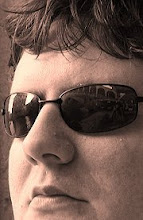I really enjoyed the first book. It's intelligent, unpredictable, original, and direct: it tells the bare facts, most of the action happens in dialogues, and there's almost no character development--all stuff that usually spells "bad lit," but which is exactly what I like, as I said last week. I have some reservations, of course, but overall my opinion is positive.
Plot recap. In a very far future, four quadrillion humans populate the Milky Way, united under the huge Galactic Empire. A dying psychologist, Hari Seldon, develops the science of psychohistory, which allows mathematical prediction of the behavior of very large populations. Seldon predicts the Empire will fall within a few generations, and 30,000 years of barbarism will follow before a second Empire will rise and re-unite the galaxy. The fall is by now inevitable, but Seldon develops a Plan to preserve human knowledge afterwards, an intellectual ark to shorten the upcoming middle ages to a mere 1,000 years.
He creates two Foundations of a few thousand settlers at opposite ends of the galaxy. The first Foundation is on Terminus, a small and barren planet in the extreme periphery of the Empire. In the coming decades, Terminus endures a series of "Seldon crises," crucial moments when the Foundation must ensure history follows the Seldon Plan. The first few Seldon crises concern the Four Kingdoms, powerful warmongering planets that threaten to invade Terminus. The Foundation keeps them at bay first with atomic power and then with free trade. Since knowledge of atomic power is already lost in the outer systems, the Foundation introduces its atom-based technology as a religion: its agents pose as "high priests" who are the sole keepers of atomic power plants. Terminus traders, then, establish a clever symbiotic relationship with the Kingdoms, making them purchase household atomic gadgets with food and raw materials. At the end of the book, though, characters realize that rules are changing fast. Korell, a planet closer to the center of the galaxy than the Kingdoms, has retained some knowledge of atomic power and even has some old Imperial starships and weapons. The Foundation's religion is thus ineffectual, and Korell can only be controlled by pure trade devoid of mysticism. Here Asimov suggests that the Foundation will need to keep reinventing its policies as it expands closer to the galaxy's center, where the Empire is still alive and well... for now anyway.
This plot just begs reading. No sci-fi before or since has tackled human history on such a large scale. The only way to make this gargantuan storyarc readable is to focus on facts and single episodes, so the book does read like a summary, and that too abridged... but once again that's fine by me. A negative side effect is that characters are limited to stock American white males. They all speak and act like post-WWII, pre-Cold War era stereotypes: scorfnul, sexist, and a bit racist. It's a shame that a novel with this scope should be written at a time of relative intellectual hegemony, between two major revolutions. Asimov does eschew self-righteous patriotism, though. The Foundation is not Captain America but rather a stalwart of universal (progressive) principles of science and knowledge. If anything, the novel could have been seen as somewhat anti-American upon release: the Foundation prevails thanks to a careful handling of free trade and State-supported religion, two mainstays of the U.S. after WWII. By portraying free trade and religion as little more than organized manipulations of the masses, Asimov is obviously trading jabs at capitalism. It must help that he's a Soviet-turned-American!
A little less forgivable is that he completely ignores the role of women and children, a grave miss in a sociological tale. You write a novel about the preservation of all human knowledge in a time of barbarism and you "forget" to discuss things like procreation, education policies, civil rights, or anything other than the (puerile) cabinet politics of rich white men? Even just in the 1970s he would have been crucified for this. Along the same lines, the novel forgoes any talk of genetic engineering and bioethics, preferring instead the typical, morbid post-WWII infatuation with all things atomic. Asimov can't be fully blamed for all this, though. The genetic turn, for example, was unforeseeable even for an erudite futurist like him at a time when DNA hadn't even been identified; and times probably just weren't mature enough for more social-oriented considerations. Also, perhaps some of these issues are addressed in future Foundation books, which he kept writing well into the 1980s. We'll see.
When all's said and done, the book's main asset remains that it embodies what science-fiction should always be about: a projection of a possible, future state of affairs based on historical, sociological, psychological, and philosophical hypotheses. Science fiction is unwritten history, and the masters of the genre interpret it this way, surely influenced by the "Three Greats": Isaac Asimov, Arthur Clarke, and Robert Heinlein, to whom I might add Philip Dick (not to mention other major authors like Ursula LeGuin and Kurt Vonnegut, who have ventured into sci-fi but not often enough to be properly called "sci-fi authors"). In Foundation, the genius idea of psychohistory follows these canons. It lends a side to philosophical considerations about free will and predestination which Asimov acknowledges even in this first novel. The idea is fascinating that psychohistory can predict the future of the masses with great precision but is completely unable to make predictions about any one individual. As the Master Trader Hober Mallow explains halfway through the novel, given a large enough population some individual is likely to come along whose characteristics are necessary and sufficient to fulfill the task at hand and keep the Seldon Plan on track... and that's a fantastic metaphor for the workings of actual, past history.
As my father wryly reminds me, in the second novel a new menace comes from "the Mule," a humanoid mutant with extrasensory, psychic abilities that Seldon could not predict and who thus seriously endangers the Plan. I look forward to that! For now I just wish, perhaps childishly, that this kind of novel had been written later in the 20th century, when a wider variety of issues could be tackled and factored in the Seldon Plan. But ah well. :-)






0 comments:
Post a Comment